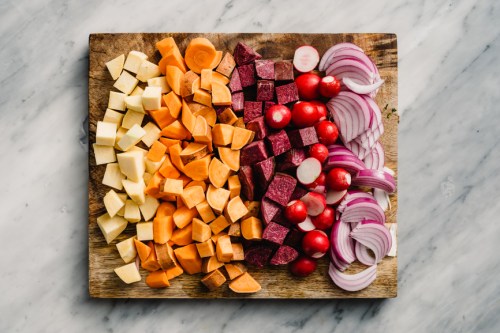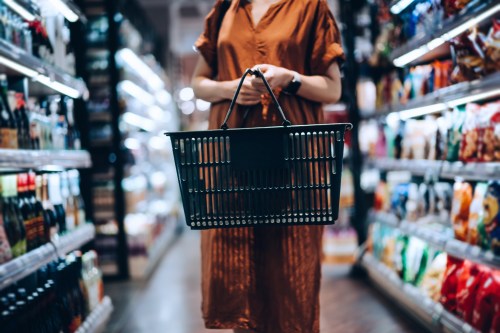Our editors independently select these products. Making a purchase through our links may earn Well+Good a commission
Although we may go to the farmer’s market with a preconceived notion that we will *always* find fresh, juicy, ruby red strawberries available between the months of April and July, that may not always be the case. Why? Well, as much as we’d like to hope for, produce seasons aren’t always set in stone. That’s to say, some seasons may run short, long, or not at all depending on the conditions that year.
Experts in This Article
We spoke with two farmers that shared why shopping for foods “in season” might not always mean what we think. Plus, why forming a strong relationship with your local farmer—instead of crafting your weekly shopping list based on seasonal produce guides that you find on Pinterest—will help give you insights into what the latest harvest may look like…and what actually is in season at any given time.
What farmers want you to know about shopping for food that’s “in season”
According to Farmer Lee Jones, the farmer behind The Chef’s Garden and author of The Chef’s Garden: A Modern Guide to Common and Unusual Vegetables, the most common mistake folks make when it comes to shopping for seasonal produce is assuming that there is a very distinct, concrete, and consistent harvest season.
“Growing seasons shift and change year over year,” Jones says. “These changes are often impacted by the timing of spring thaw, summer heat, and first frost. At Chef’s Garden, we take our cues from mother nature, so we take it all in stride.” Asparagus, he says, is a great example. “Our growing season in Ohio is May to June, and then [it’s] no longer available from our farm. However, you will find asparagus in the grocery stores all year round. We, conversely, believe that you should eat asparagus three times a day when it is in season and lust for it for the next 11 months.”
Though seasonal produce guides can provide a rough estimate of which (and when) foods will be in season, they shouldn’t be considered the end-all-be-all. According to Tracy Hayhurst, culinary director and former farm manager of Husky Meadows Farm, this is because the weather tends to play a significant role in every season’s harvest.
“Farming seasons vary a good deal depending on the weather,” Hayhurst says. “If you are mindful of what’s happening outside, then you can likely anticipate that some crops will be early if the weather has been unseasonably warm in the spring, and the same for the fall. Many people assume that Labor Day and kids going back to school marks the beginning of fall crops. While we do have the beginnings of things like winter squash then, we usually are just reaching our peak for things like red peppers and eggplants. Even summer squash and cucumbers can still be harvested through the month.” A fall without early frosts tends to prolong the season, she says, but if it has been unseasonably cool, “you might have a longer spring season and see more greens like spinach [and] arugula.”
But the temperature isn’t the only factor involved. “Rainfall also has a huge effect on the season. Rainy, wet springs may hold up the first planting dates causing crops to be a little bit later. Rainy summers and falls may be great for some crops like greens, but may cause rot and an early end to crops like nightshades,” Hayhurst says.
So, how should you shop for seasonal produce, according to the experts?
When you consider these vast year-to-year, month-to-month variations, it’s easy to see why both farmers agree that the best way to shop for seasonal produce comes down to sourcing. “Most of these questions can be addressed through the simple act of buying directly from local farmers, because eating what is in season really depends on your region. You really can’t have seasonal eating without having regional eating,” says Hayhurst.
The best way to go about this, Hayhurst adds, is to shop at a farmers market, farm stand, or community supported agriculture (CSA). “This means getting to know your local farmers, which can help you navigate regional eating as you dip your toes into the real meaning behind eating seasonally,” she says.
Meanwhile, Jones explains that a tried and true way of knowing how fresh something really is by inspecting how it looks and feels. “When looking for fresh seasonal vegetables, look for bright, vibrant colors. That is a sign they’re full of phytonutrients and full of flavor. Touch the produce and make sure it is firm and free of blemishes and soft spots. When something is truly in season, you will get fresher and more flavorful produce,” Jones says.
Hayhurst adds that fruits and veggies aren’t the only foods affected by seasons. According to her, grass-fed, pasture-raised meats will have harvest cycles of their own, too—which is important to consider when cooking for the holidays (like spring lamb for Easter).
Check this out to learn more about regenerative agriculture:
Sign Up for Our Daily Newsletter
Get all the latest in wellness, trends, food, fitness, beauty, and more delivered right to your inbox.
Got it, you've been added to our email list.











